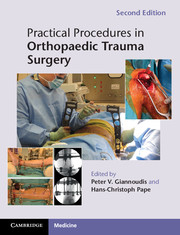Book contents
- Frontmatter
- Dedication
- Contents
- List of Contributors
- Preface
- Acknowledgements
- Part 1 Shoulder girdle
- Part 2 Upper extremity
- Part 3 Pelvis and acetabulum
- 8 Fractures of the pelvic ring
- 9 Section I: Fractures of the acetabulum
- Part 4 Lower extremity
- Part 5 Spine
- Part 6 Tendon injuries
- Part 7 Compartments
- Index
8 - Fractures of the pelvic ring
Published online by Cambridge University Press: 05 February 2014
- Frontmatter
- Dedication
- Contents
- List of Contributors
- Preface
- Acknowledgements
- Part 1 Shoulder girdle
- Part 2 Upper extremity
- Part 3 Pelvis and acetabulum
- 8 Fractures of the pelvic ring
- 9 Section I: Fractures of the acetabulum
- Part 4 Lower extremity
- Part 5 Spine
- Part 6 Tendon injuries
- Part 7 Compartments
- Index
Summary
Indications
Unstable pelvic fractures: AP-II, AP-III, LC-II, LC-III, vertical shear fractures and fractures with combined mechanism of injury according to the Young–Burgess classification. LC-I pelvic fractures with a complete sacral fracture or proven unstable after manipulation under anaesthesia.
The anterior external fixation of the pelvis might be used as a part of the resuscitation process for the above injuries, or it can be used as the definitive fixation device to restore the normal biomechanics of the pelvic ring.
When the anterior external fixator is used in the context of the damage control orthopaedics concept to temporarily stabilize the patient's haemodynamic condition, it can be exchanged to an internal fixation, depending on fracture configuration and the physiologic status of the patient. This usually takes place after the fourth or fifth day from the time of the injury.
Clinical assessment
Check and document the neurovascular status of the lower extremities.
Check the condition of soft tissues around the pelvis. Document any abrasion, ecchymosis/haematoma and degloving injuries. This might have an implication for the postoperative course of the patient.
Pay special attention to inspection of the perineum area. Any open wound or indirect signs of injury of the urogenital system should be identified. Check the urethral meatus for blood, and in men perform a rectal digital examination to evaluate the position of the prostate.
Check for pelvic asymmetry and leg-length discrepancy. When the latter is present it denotes either an ipsilateral fracture of the lower extremity or an ipsilateral vertical shear injury of the pelvis.
- Type
- Chapter
- Information
- Practical Procedures in Orthopaedic Trauma Surgery , pp. 178 - 211Publisher: Cambridge University PressPrint publication year: 2014

